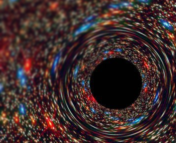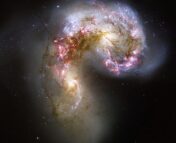Authors: Sara L. Ellison, Mallory D. Thorp, Lihwai Lin, Hsi-An Pan, Asa F. L. Bluck, Jillian M. Scudder, Hossen Teimoorinia, Sebastian F. Sanchez, Mark Sargent
First Author’s Institution: Department of Physics & Astronomy, University of Victoria
Status: Accepted to MNRAS, open access on ArXiv
The star-formation main sequence (SFMS; Figure 1) is a key concept in modern extragalactic astrophysics. In brief, it describes the tight positive relationship between the stellar mass of a galaxy and its star-formation rate (SFR). Interpretations of the SFMS have varied over the past decade since its discovery, and although much discussion has taken place, the meaning and evolution of the SFMS remains a hotly contested subject.
Perhaps more importantly is the scatter of the SFMS, which describes the extent to which galaxies appear to have an enhanced or suppressed star-formation. If indeed the scatter is due to a real phenomenon (as opposed to noisy data), then what drives galaxies above the SFMS? Is there a larger underlying molecular gas reservoir from which more stars form, or is the star-formation itself more efficient? The answer is still unclear.

The way we observe these galaxies affects how we can approach this problem. For the vast majority of galaxy surveys using imaging, we usually measure the total light of a galaxy. For large spectroscopic surveys, typically only the light from the bright, easy to observe galaxy cores are measured. And as we know from the beautiful Hubble imaging, galaxy properties vary significantly between the central bulge, disk, and outskirts.
However, the local universe provides. Since these galaxies are so close, they appear large on the sky to the point where we can dissect them in either imaging or more recently, with integral field spectroscopy (IFU). These IFU measurements allow us to obtain many spectra of a single galaxy within many spectral pixels, or spaxels. The research enabled by this technology has been revolutionary, to say the least.
In this astrobite, the SFMS and its drivers are put under the microscope – or should I say, a telescope with many simultaneous integral field units!
Enter the Mapping Nearby Galaxies at the Apache Point Observatory (MaNGA) survey, part of the Sloan Digital Sky Survey IV (SDSS-IV). Its goal is to obtain spatially resolved spectroscopy for ~10,000 galaxies so that we may better understand galaxies with comprehensive, resolved measurements. Questions such as the nature of the SFMS are on its to-do list.
To understand the role of gas in driving the SFMS, MaNGA has been coupled with well-resolved measurements with Atacama Large Millimeter Array (ALMA) to form ALMaQUEST. With information such as star-formation rate and stellar mass coming from MaNGA and complementary gas mass estimates from ALMA, it is possible to begin to understand the SFMS with the added advantage of spatial resolution.
The authors select 46 galaxies which have such measurements. For each of the ~12,000 spaxels they compute the stellar mass, star-formation rate, molecular gas mass in terms of surface densities, Σ (i.e. dividing by area), in addition to the per-spaxel star-formation efficiency (SFE; the ratio of SFR to molecular gas mass). They also consider the relative excess of these quantities compared to average galaxies, Δ.
Unlike global measurements with single sightlines, these resolved local measurements probe the real physics on the scales (~kpc) over which star-formation occurs.

To quantify the extent to which an enhancement in gas fraction or SFE contributes to elevating a spaxel above the SFMS, the authors calculate the correlation strengths of the SFR surface density and its excess with several candidate factors, as shown in Figure 2. A machine learning approach utilizing a non-linear regression with an artificial neural network (ANN) is also used to compute the correlations, with similar results.
This quantification (in blue) firstly confirms that the most strongly correlated variable of the SFR surface density is the molecular gas mass surface density (leftmost column), which is a well-known correlation known as the Kennicutt-Schmidt relation.
The main result, however, comes from correlation with excess SFR (in orange). They find that the primary explanatory variable is excess SFE, and not gas mass as before. This finding demonstrates that the extent to which a spaxel experiences an enhancement or suppression of star-formation (and hence its scatter above/below the SFMS) is driven by the SFE. In other words, the increase in star-formation seems to be due to greater efficiency at converting gas into stars. The excess gas mass is then only a secondary driving factor (rightmost column).
This is a key piece of evidence supporting the view that galaxies do not experience an increase in star-formation simply from added gas. They must also be more efficient at converting that gas into stars. One potential caveat, however, is the poorly understood conversion between tracers observable by ALMA (e.g. CO, [CI], and dust) and the true molecular gas mass. Much needed improvement in this area may serve to further clarify these results.





Hi John, thanks for the bite! I enjoyed it a lot. Great to hear we are a step closer in understanding the process behind starburst.
Cheers,
Manuel
Hi Manuel, Thank you for the comment!
Cheers,
John